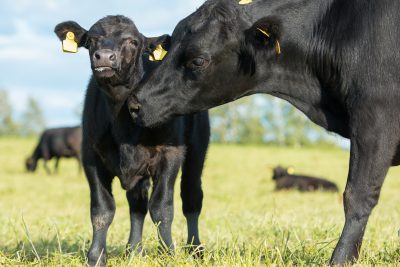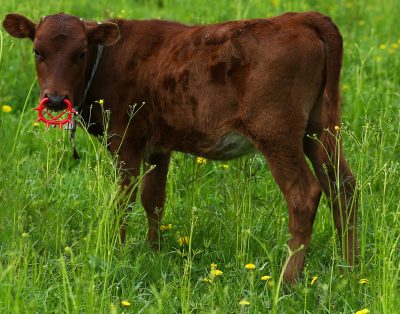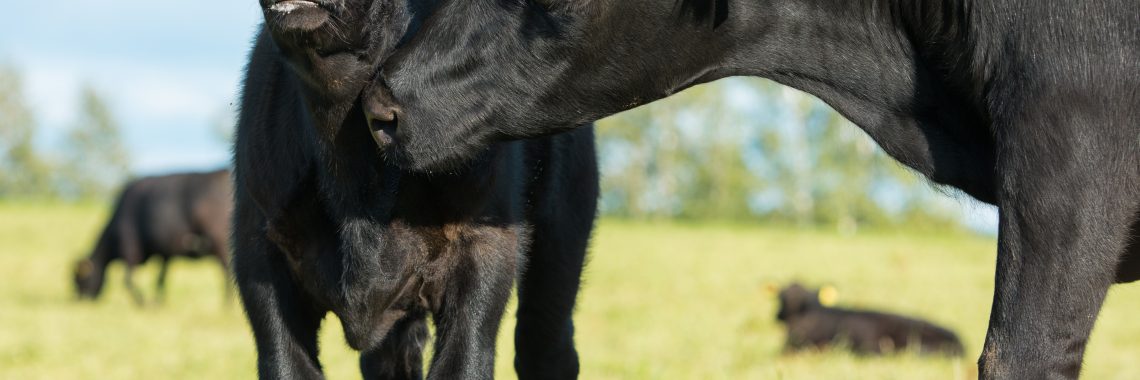Spring calving cow-calf producers are approaching weaning time, which can be a stressful time for both calves and producers. How a producer manages calves prior, during, and after weaning can have a dramatic influence on calf performance and economic viability (Justice et. al., 2021). To make weaning less stressful, it is important to create a plan that best fits your management goals and resources.

Make a plan
When formulating a plan, first consider whether you want to sell your calf crop or retain ownership of some or all of your calves. When deciding whether to sell or retain ownership of your calves, make sure to factor in current and future market price; current hay inventory; feed and supplementation costs; labor cost of retaining calves; space availability; and risk associated with retaining calves.
The next step is to identify the type of separation (type of weaning), if weaning weights will be collected, and if preconditioning will be implemented. During weaning, separating calves from their dams causes behavioral changes such as vocalization, walking fences, and reduced feed intake, which can result in increased stress, increased health concerns, and reduced performance (Jenkins, Griffin, and Stalker, 2015). Choose the separation method that works best for your operation while taking as many precautions as possible to reduce risk, maintain performance, and reduce illness.
Traditional weaning
Separation methods include traditional, fenceline, and two-stage weaning. Traditional weaning consists of abrupt and total separation of the cow and calf. Calves are typically moved to a new environment, such as a pasture or drylot, often resulting in high amount of stress as cows and calves search for one another. Calves and cows may engage in fence walking and vocalization that can last up to 3 days (Justice et. al., 2021; Jenkins, Griffin, and Stalker, 2015).
Fenceline weaning
Fenceline weaning is when cows and calves are placed on opposite sides of a fence. Fenceline weaning usually takes 5–7 days but it has shown to be a less stressful practice that results in fewer vocalizations, less fence walking, and more weight gain postweaning compared to traditional weaning of calves.
For best results, you need to have a tight fenceline and ensure that adjacent pastures share a fence long enough for the cows and calves to spread out and maintain relatively close physical proximity. The cows should be removed from the pasture that the pairs were occupying so that the calves can stay in the familiar pasture. Doing this will reduce the stress on claves since they are accustomed to the watering and feeding location. Note that this practice requires fencing that is in good condition and reinforced so that calves and cows cannot get through to the other side.
Two-stage weaning

Two-stage weaning is a third option to consider. In stage one, a nose flap/nose piece (often referred to as weaner) is placed in the nose of the calf (see Figure 1). This device allows calves to graze grass and drink water, but it does not allow them to nurse. Two-stage weaning is less stressful than traditional weaning because it allows calves to stay with their dams while adjusting to not having milk. Stage one usually lasts 10–14 days.
In stage two, the nose piece comes off and the cows and calves are separated like in traditional weaning. However, because calves were by their dams while being weaned, separation is less stressful and will result in less vocalization and fence walking than traditional weaning. Before implementing this practice, producers should consider the extra days it takes for calves to be weaned, the added cost of nose pieces (even though they are reusable), and the added labor required to bring calves through the chute to install and remove the nose piece.
No matter what weaning strategy you choose, there are additional management strategies to reduce stress on weaned calves. Preconditioning, proper vaccination protocol, clean water, high nutritional forage, and fly control are all practices that reduce a calf’s stress and encourage better performance.
Pre-conditioning programs
Effective preconditioning programs help calves become accustomed to being weaned. Calves are usually preconditioned for at least 45 days prior to being sold. Preconditioning is designed to reduce stress that occurs during the transitional period between weaning and going on feed or moving into the next production cycle. This management practice is intended to optimize the calf’s immune system and nutritional status while reducing stress (Lalman and Mourer, 2017). When done properly, preconditioning is the best program available for preventing shipping fever and bovine respiratory disease (BRD) while improving weight gains and potentially obtaining a premium on your calves (Bremer, 2015). Calves that have been effectively preconditioned increase their value by promoting calf growth, enhancing immune system function, and minimizing calf stress (Parish, Rhinehart, and Boland, 2017). Effective preconditioning also allows producers to build a reputation for high-quality cattle.
A good preconditioning program focuses on three major areas:
- Immunization against disease: A successful preconditioning program must include a proper vaccination program. This is essential to reducing the risk of diseases. Please consult a local vet to establish a vaccination protocol that best suits your operation and herd. Additionally, a proper fly control program not only reduces stress on the calves but is also important in managing livestock health and performance.
- Management: A proper preconditioning program requires good management, including additional labor to ensure that calves are feed bunk broke, healthy, and gaining weight.
- Proper nutrition: During preconditioning, it is critical that calves are fed high quality feed that is balanced for energy, protein, minerals, and vitamins while meeting their nutritional requirements to reduce stress and increase weight gain. It is also important that calves are provided with clean water, preferably in a trough so that they get acquainted with this type of water source. Calves usually experience shrinkage associated with weaning, but with proper nutrition they can gain 30–50lbs during a 30-day preconditioning program.
Ensuring that the three major areas of a preconditioning programs are met requires extra resources, including labor, vaccinations, death loss, additional feed costs, and interest expenses on borrowed money. Two additional factors to consider are the seasonal patterns of the cattle market and the price slide on increased calf weights. Therefore, before you decide to precondition your calves, consider the following.
- Can you afford the added cost?
- Seasonal patterns of the cattle market
- Current market price vs. future market price for heavier calves
- Do you have the proper additional resources?
- Labor
- Feed
- Facilities
- How will a 45-day retention to precondition calves affect your grazing plan?
Summary
Weaning can be a stressful time for your herd, but there are a variety of strategies that can mitigate the stress your calves experience before and after weaning. It is important that calves are handled with as little stress as possible so as to encourage good performance and reduce the chances of health issues. Before weaning, evaluate your goals and resources to determine a weaning strategy that works best for your operation. Also, carefully consider the pros and cons of a preconditioning program before to deciding to precondition your calves.
Sources for Further Reading on Preparing for Weaning
Bremer. M., 2015. Preconditioning Calves: Can it Add Value? University of Nebraska Lincoln. UNL Beef. https://beef.unl.edu/preconditioning-calves-can-it-add-value
Jenkins. K.H., Griffin. D., and Stalker. A., 2015. Management, Health, and Nutritional Considerations for Weaning Calves. University of Nebraska Lincoln. UNL Beef. https://beef.unl.edu/management-health-and-nutritional-considerations-weaning-calves
Justice. M., Mullenix. K., Elmore. M., Rodning. S., and Chamorro. M., 2021. Weaning Methods for Beef Cow-Calf Operations. Alabama A&M and Auburn Universities Extension. https://www.aces.edu/wp-content/uploads/2021/09/ANR-2823_WeaningBeefCowCalf_083121L-G.pdf
Lalman. D., and Mourer. G., 2017. Effects of Preconditioning on Health, Performance and Prices of Weaned Calves. Oklahoma State University. Oklahoma Cooperative Extension. https://extension.okstate.edu/fact-sheets/print-publications/afs/effects-of-preconditioning-on-health-performance-and-prices-of-weaned-calves-afs-3529.pdf
Parish. J.A., Rhinehart. J. D., and Boland. H.T., 2017. Beef Calf Preconditioning Programs. Mississippi State University Extension. https://extension.msstate.edu/sites/default/files/publications/publications/p2578.pdf




